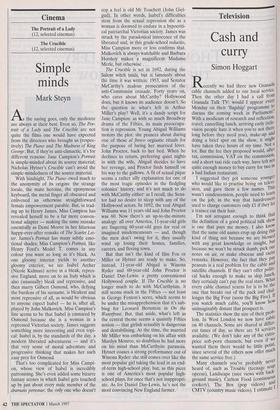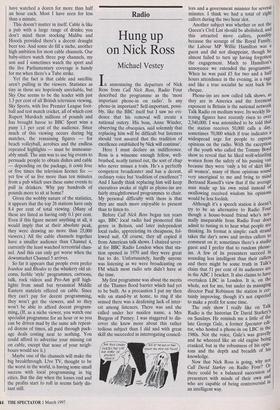Television
Cash and curry
Simon Hoggart Recently we had three new Granada cable channels added to our local service. Then the other day I had a call from Granada Talk TV: would I appear every Monday on their 'flagship' programme to discuss the coming week in Parliament? With a modicum of research and reflection, travel, cancelling lunch, arriving early (tele' vision people hate it when you're not there long before they need you), make-up and doing a brief spot on the show, it might have taken three hours of my time. Not a lot. But the fee they proposed would, after tax, commission, VAT on the commission, and a short taxi ride each way, have left not quite enough money to buy curry for two in a bad Indian restaurant.
I suggested they got someone younger who would like to practise being on televi" sion, and gave them a few names. This wasn't condescension, people need to learn on the job, in the way that hairdressers used to charge customers only £1 if they let a trainee cut their hair. I'm not arrogant enough to think that the definition of a good political talk show is one that pays me money. I also know that the same old names crop up doing this kind of thing not because we are blessed with any great knowledge or insight, but because we won't be struck dumb, pick our noses on air, or make obscene and racist remarks. However, the fact that they PaY, peanuts is a real problem for the cable and satellite channels. If they can't offer politi- cal hacks enough to make us skip lunch, they certainly can't pay the real stars. What every cable channel yearns for is to be the one that breaks out of the pack and chal- lenges the Big Four (soon the Big Five). It you watch much cable, you'll know how unimaginably distant that prospect is. The statistics show the size of their prob.' lem. In West London we now have cable on 40 channels. Some are shared at differ- ent times of day, so there are 54 services available. (We don't take any of the extra' price soft-porn channels, but even if we wanted them there would be little paint, since several of the others now offer much the same service free.) Many channels you've probably never heard of, such as Trouble (teenage soap operas), Landscape (nice views with back- ground music), Carlton Food (continued cookery), The Box (pop videos) and CMTV (country music videos). I estimate " have watched a dozen for more than half an hour each. Most I have seen for less than a minute.
This doesn't matter in itself. Cable is like a pub with a large range of drinks; you don't mind them stocking Malibu and Hooch provided there's a decent draught beer too. And some do fill a niche, another high ambition for most cable channels. Our baby-sitters watch three pop channels, my son and I sometimes watch the sport and the live Parliamentary coverage is handy for me when there's a Tube strike.
Yet the fact is that cable and satellite aren't pulling in the viewers. Statistics as tiny as these are hopelessly unreliable, but Sky One seems to be the leader with just 1.3 per cent of all British television viewing. Sky Sports, with live Premier League foot- ball and test match cricket, all of which cost Rupert Murdoch millions of pounds and has brought havoc to BBC Sport wins a puny 1.1 per cent of the audience. Since much of this viewing occurs during big matches, the remaining figures — for beach volleyball, aerobics and the endless repeated highlights — must be immeasur- ably small. The aim was to use big events to persuade people to obtain dishes and cable — depending on the package, it costs four or five times the television licence fee yet few of us live more than ten minutes from a pub which uses these same events to pull in drinkers. Why pay hundreds of pounds more to sit at home?
Given the wobbly nature of the statistics, it appears that the top 26 stations have only 8.4 per cent of total viewing. (Many of these are listed as having only 0.1 per cent. Even if this figure meant anything at all, it would imply that at their absolute peak, they were drawing no more than 25,000 viewers.) All the cable channels together have a smaller audience than Channel 4, currently the least watched terrestrial chan- nel. And this can only get worse when the downmarket Channel 5 arrives.
So far it appears that people even prefer Ivanhoe and Rhodes to the whiskery old sit- coms, feeble 'style' programmes, cartoons, talk, rock videos and Pro-Am golf high- lights from small but tyrannical Middle Eastern statelets offered on cable. Since they can't pay for decent programming, they won't get the viewers, and so they won't be able to afford decent program- ming_ (If, as a niche viewer, you watch one specialist programme for an hour or so you can be driven mad by the same ads repeat- ed dozens of times, all paid through pack- age deals costing next to nothing. You could afford to advertise your missing cat on cable, except that none of your neigh- bours would see it.) Maybe one of the channels will make the big breakthrough. L!ve TV, thought to be the worst in the world, is having some small success with local programming in big cities. But the day when the losses end and the profits start to roll in seems fairly dis- tant still.



























































 Previous page
Previous page